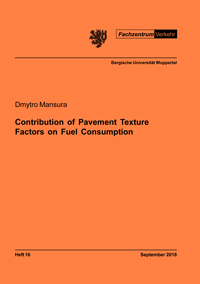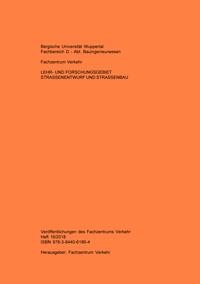
Shop : Details
Shop
Details
49,80 €ISBN 978-3-8440-6186-4Softcover260 pages176 figures387 g21 x 14,8 cmEnglishThesis
September 2018
Dmytro Mansura
Contribution of Pavement Texture Factors on Fuel Consumption
Rolling resistance (RR) is a comprehensive term that embraces three major energy dissipation mechanisms (tyre macro-distortion, tyre micro-distortion and pavement macro-distortion), all of which cause more compression in a leading end than in a trailing end of a contact patch. This accounts for an average of 119 MJ/liters of fuel per car yearly. A slight rearrangement in surface texture may therefore decrease fuel consumption bringing substantial long-term socio-economic benefits, which would help in meeting EU limits on CO2 (95 g/km until 2021) fostering sustainable construction of pavements.
This study describes a newly developed multi-scale 3-D numerical model and two in-laboratory and one in-situ experimental tests to calculate micro-distortional RR due to indentation of aggregates into visco-elastic tread compound. Two computational and two experimental approaches to quantify micro-distortional RR were developed. The contact forces appeared of a reasonable distribution and magnitude. It was found that micro-distortional RR is higher on a rougher/sparsely packed surface compared to a smoother/tightly packed case; longitudinally grooved concrete was the most energy efficient texture studied. The predictions were confirmed qualitatively using the experiments developed.
A numerical solution and experimental techniques can be implemented into Life-Cycle Analysis, allowing a texture-related fuel consumption assessment during the service life stage. The findings confirm that stone-based RR can be substantial in magnitude, but conclusions on low/optimal/sustainable RR texture packing can only be made if friction/drainage/noise and rubber properties are considered together.
This study describes a newly developed multi-scale 3-D numerical model and two in-laboratory and one in-situ experimental tests to calculate micro-distortional RR due to indentation of aggregates into visco-elastic tread compound. Two computational and two experimental approaches to quantify micro-distortional RR were developed. The contact forces appeared of a reasonable distribution and magnitude. It was found that micro-distortional RR is higher on a rougher/sparsely packed surface compared to a smoother/tightly packed case; longitudinally grooved concrete was the most energy efficient texture studied. The predictions were confirmed qualitatively using the experiments developed.
A numerical solution and experimental techniques can be implemented into Life-Cycle Analysis, allowing a texture-related fuel consumption assessment during the service life stage. The findings confirm that stone-based RR can be substantial in magnitude, but conclusions on low/optimal/sustainable RR texture packing can only be made if friction/drainage/noise and rubber properties are considered together.
Keywords: pavement surface; micro-distortional rolling resistance; numerical model; experiments
Export of bibliographic data
Shaker Verlag GmbH
Am Langen Graben 15a
52353 Düren
Germany
Am Langen Graben 15a
52353 Düren
Germany
Mon. - Thurs. 8:00 a.m. to 4:00 p.m.
Fri. 8:00 a.m. to 3:00 p.m.
Fri. 8:00 a.m. to 3:00 p.m.
Contact us. We will be happy to help you.



